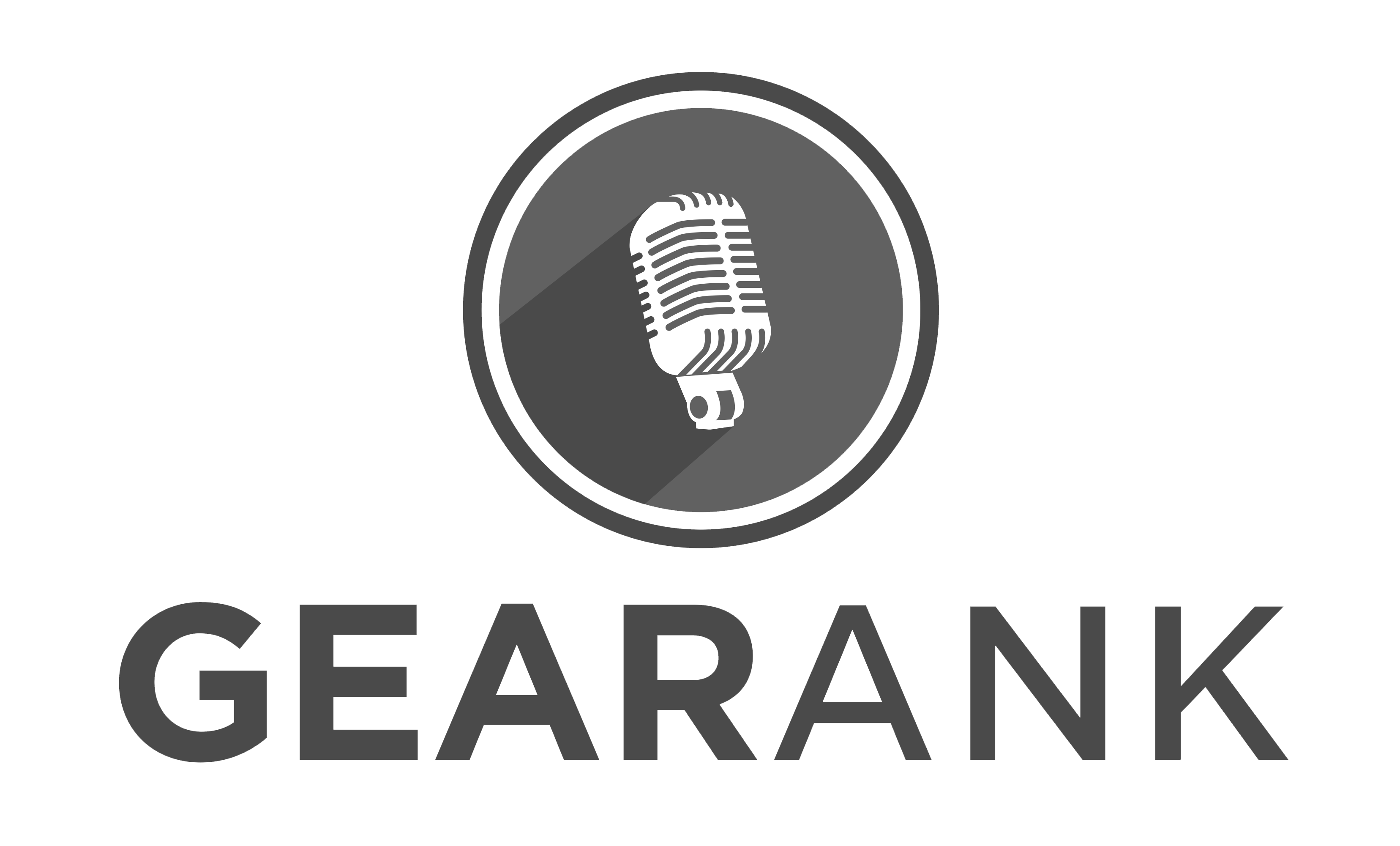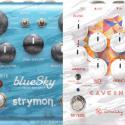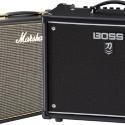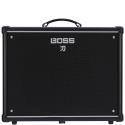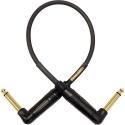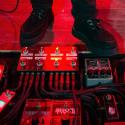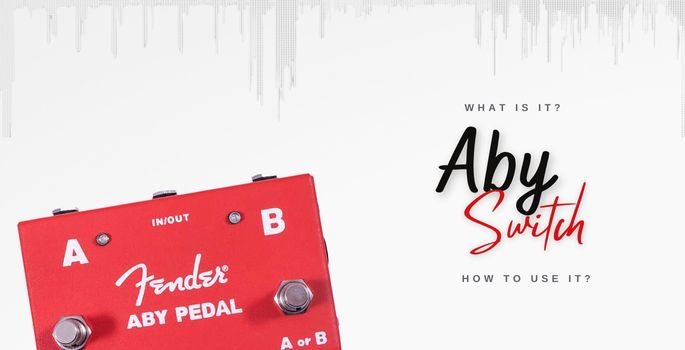
Are you looking to expand your tone with more amps and pedals? Then you need an ABY switch.
This device can split your electric guitar signal and drive the two outputs to different destinations.
“A” and “B” stand for the two signals you want to combine or switch between. While “Y” denotes the split of the incoming signal after it enters the ABY pedal. It gives you control over the outputs, allowing for “A & B” stereo blending, and “A or B” switching functionality.
This versatile switching makes it a valuable piece of equipment for signal chain routing. Here we’ll look at the ABY switches in more detail to see its uses and benefits.
What Do You Use An ABY Pedal For?
ABY pedals are also called splitter pedals because of how they can divide the input signal into two.
This allows you to process your audio signal in two different ways and switch between them or blend them together.
It is commonly used as an amp switcher for expanding your palette sonically. It frees you from being limited to one amp or signal chain.
You can plug the two independent signals into different amps or pedals. And this gives you more tone flavors to play with.
An excellent example of this is using a certain amp for clean sound and switching to another amp for distortion. The ABY Switcher Pedal will let you swap between the two amps and even allow you to play them simultaneously.
This versatile switching makes it a valuable piece of equipment for signal chain routing. Here we’ll look at ABY switches in more detail to see its uses and benefits.
Who Uses An ABY Switcher Pedal?
ABY is a great asset for guitarists who want to solve complex audio switching problems. But it can be overkill for those who are into minimalist setups and basic cable runs.
If you’re looking to use different amps and combine them for different tones, then this is a must-have. Pros often combine different flavored amps for a bigger and more harmonically rich tone.
Eric Johnson and John Mayer are good examples of virtuosos who employ complex amp switching setups.
Active And Passive Pedals
For a long time, switcher pedals had passive circuitry, and there wasn’t much of a choice. But these days, there are now plenty of active splitter/ switcher pedals to choose from.
Active ABYs need to be plugged in like the majority of guitar pedals to function. Passive ABYs do not need power.
Passive
A passive ABY will direct the guitar signal toward one amp or the other without an electrical amplifier or “buffer” to control the signal.
Passive switchers are preferred by some tone purists because they don’t alter the guitar signal. They operate like a straightforward Y-jack wire. Note that the signal that passes through each amp is cut in half when operating two amps at once.
In addition to purity of tone, these pedals are practical and easier to integrate into pedalboards since they don’t require power. Except for those with LED indicators, passive ABY pedals generally don’t need any extra electricity to operate.
Active
Active circuits have a unity-gain amplifier or buffer. This allows them to lower the impedance of high impedance signals, which lessens noise. Active circuits also usually come with more tone shaping and control over the electrical signal.
The capacitors in the signal channel also prevent noise that might be coming from the amp from leaking back into the instrument. A buffer not only sends but takes the signal further without noise.
The downside is that they need a power supply unit (PSU) to operate. But it’s not a big downside considering that complex setups already involve the use of power supplies.
Which is the better ABY Pedal – Buffered Or True Bypass?
The use of a buffer or true bypass switching is a crucial distinction to make between the various ABY guitar pedals available on the market. Each has its own advantages and quirks, which will be discussed in detail below.
Buffered ABY Pedals
Buffered pedals increase signal strength to prevent the loss of sonic details. This is especially important when using long cables and when your signal path involves multiple pedals and amps.
Buffered pedals deal with switching noise in these two ways.
IC Circuit – Most modern pedals utilize an integrated circuit (IC). This adds thousands of transistors to produce lots of gains and greater efficiency. Note that some guitarists aren’t keen on the tone these buffers create. They have a clear sound, but the highs can be too harsh or trebly.
Class A Circuit – The other method is a class A circuit. Individual transistors are employed at each gain stage. This indicates that only the barest minimum of negative feedback is used. This results in a clear and pure tone, with less of the harsh highs.
If you want tone shaping and some coloration, then you’re better off with a buffered splitter.
There’s really no avoiding a buffered circuit in today’s PA systems and recording studios. Sound engineers use them for better control and for minimizing noise. Another important option for lowering noise is using a Noise Gate.
True Bypass ABY Switcher Pedals
When not in use, this type of circuitry allows the signal to bypass the pedal’s internal circuitry, essentially directing your signal to the output cable.
This reduces the length of signal travel and skips the components that can negatively impact tone. The result is a more natural sound that is not colored by a buffer circuit.
But there are drawbacks to True-bypass pedals. One of which is their susceptibility to switching noises.
A true bypass footswitch is an electronic relay switch that is operated via foot. These produce a noticeable pop as the foot switch activates the internal relay. And this pop is most noticeable when utilizing distorted or high-gain amps.
If this is an issue for you, you can use an optocoupler. This can ramp up or down the signal for a smoother and silent transition. To accomplish this, Optocouplers use an internal light and receptor. Note that these are pricey and aren’t as widely available.
Creating A Stereo Amp Rig
Many recorded guitars are double-tracked and heavily panned left and right in music production.
To achieve this in live performance, some musicians opt for a stereo rig with multiple amps. They usually use two amps spaced far left and far right to produce the same stereo sound.
In addition to amps, effects are also often employed in a stereo setup. Many modern pedals contain dual inputs and outputs with the letters “L” and “R” denoting left and right. You’ll see these on effects like delay, reverb, and modulation, among others. Properly using their stereo capabilities can significantly improve your overall sound.
One good example is the “ping-pong delay“, which will cause your sound to bounce across the speakers of each amp. This offers an incredible audio experience, and guitarists frequently utilize this on stage or in the studio.
Phase Cancellation and How to Resolve It
You can sometimes run across the issue of phase cancellation. Phase issues happen when two frequencies that are highly similar to each other are played at the same time. This then results in signal loss as the waveforms collide.
If both amplifiers are turned on while you’re playing a guitar riff, the sound waveform that represents the riff will be double-tracked. This waveform will be replayed through each speaker in time. Phase cancellation will diminish the overall tone because the frequencies of the riff will move at the same pace.
An ABY pedal can sometimes cause phase problems when using two identical-sounding amplifiers. To resolve this issue, the majority of ABY pedals have a feature known as “reverse polarity.” By inverting either of the two signals using the polarity switch, phase cancellation is avoided.
Preventing Buzz And Humming
When two amplifiers connect and simultaneously share an audio and electrical ground, a ground loop is created. This ground loop then causes hum and buzz. Ground lift switches can help reduce these types of issues.
Low quality components and electrical circuits can also cause stray noise to get into the electrical system. And this noise can range from minor to severe. Thankfully, popular ABY pedals like the Sonic ABY and Orange Amp Detonator use high quality electronic components.
Power Strip Issues
Some of the unwanted noise you may encounter will come from faulty power outlets and grounding. And to solve this, you’ll need to troubleshoot and test the outlets to find the ones with less noise.
Connecting your amps, pedals, and ABY box to one power strip helps as well. This guarantees that both amps are powered by the same electrical phase. But it won’t guarantee a quick fix because of different voltages and grounding configurations of amps, pedals, and venues.
Transformers
One way of dealing with unwanted hum and noise is to use a transformer.
A conventional transformer consists of an inner core, two coils, and other components. When current is applied, the first coil magnetically charges.
The second coil is subsequently activated by the magnetic field that is then passed through the core, producing an electrical current.
This builds a magnetic link that transmits audio while blocking noise and errant DC currents. There isn’t a direct electrical connection because the bridge is magnetic. This removes ground loops and disconnects the audio ground, removing the hum and buzz.
Transformers are generally passive, so you risk losing a portion of the signal, especially if you don’t have a buffer.
How To Choose The Right ABY Pedal?
Your choice will boil down to functionality, reliability, and price.
If your needs are basic, then the simple ones are the best ABY pedals to get. They are also at a lesser price point, which means you save on cost.
If you require something durable, dependable, with less noise, then you may want to look at a higher-priced pedal. These ABYs are good at maintaining the full tonal character of your amps, even as you switch or blend them together.
Conclusion
ABY switchers are used by guitarists for splitting audio signals into two. Each of the two signals can be independently processed and amplified. This allows for complex switching and blending of different amps and pedals.
This splitting and blending function is essential for stereo setups, and complex rigs with multiple amplifiers and pedals.
A buffered ABY pedal with an advanced ic chip offers you more tonal options. In contrast, true bypass switching minimizes coloration and lets you keep the original sound intact.
Now that you have a better idea of what an ABY switch is, go ahead, set up two amps and give it a try. Share your experience with everyone here in the comments below.
Frequently Asked Questions
Do ABY Pedals Work Both Ways?
You may transmit your input to both the A and B outputs at once or just the A or B output. The choice is up to you, and you can choose where you send each signal.
Do True Bypass Pedals Affect The Tone Of The Audio?
True Bypass pedals won’t affect tone. They let your audio signal go straight to the output, bypassing any internal components that may color the sound. This means that your instrument’s original tone is preserved, and you get a more natural sound.
Where Do You Place An ABY Pedal In The Chain?
ABY pedals are often placed at the end of the signal chain right before entering the amplifiers. You can use it differently depending on how you want your effects to be utilized and where you want the signal splits to be.
